The Sealing Effect Improvement Prediction of Flat Rubber Ring in Roller Bit Based on Yeoh_Revised Model
Abstract
:1. Introduction
2. Problem Description and Analysis Method
2.1. FRR Static Compression Analysis in a Roller Bit
2.2. Hyperelastic Experiment and Fitted Model
2.2.1. Mathematical Stress Formula
2.2.2. The Three Models’ (Yeoh (N = 3), Yeoh_Revised (N = 3) and Ogden (N = 3)) Fitted Stress
2.2.3. Model Goodness of Fit
2.3. Validation of the Fitted Constitutive Parameters in FEM
2.3.1. Calculation of Yeoh_Revised Jacobi Matrix (Incompressible)
2.3.2. Notes on Developing Subroutines
2.3.3. Verification of the Equivalent CAE Simulation Design for the ET (SAC) Test
3. Results and Discussion
3.1. Fitting Results Analysis
3.2. Equivalent FEM Verification Results
3.3. FEM Results of FRR under Static Compression
4. FRR Field Application
5. Conclusions
- Comparing the fitted values with the FEM-calculated data of three constitutive models, it is demonstrated that the maximum deviation between the fitted value of each constitutive model and the corresponding CAE-calculated value never exceeds ±0.5% at 120 °C, which proves the accuracy of the fitting values of the parameters of each constitutive model obtained through the least squares method in this paper.
- Compared with the Yeoh model, the Yeoh_revised and Ogden models both address the soft phenomenon encountered by the Yeoh constitutive model when predicting stress in ET (SAC) tensile tests. Moreover, the Yeoh_revised model shows the greatest improvement, with an R2 up to 0.9771, in fitting the experimental values, and its maximum underestimation is reduced to half of that of the Yeoh model.
- The Yeoh_revised constitutive model is the most accurate in fitting the experimental data. Compared with Ogden, it achieves more accurate fitting with fewer parameters (i.e., four), while the number of fitted parameters (i.e., six) is higher in the Ogden model; therefore, it is more suitable for Mises stress analysis of an FRR in a roller bit under SAC deformation.
- On the premise of ensuring the stability of sealing FRR contact stress, the maximum Mises stress obtained with the Yeoh_revised model is 1.437 MPa greater than the Yeoh model’s value of 1.413 MPa before FRR extrusion by fluid. The Yeoh_revised model is more accurate in predicting Mises stress. In the sealing process (i.e., after FRR extrusion by fluid), the Mises stress obtained with the Yeoh_revised model is twice the value obtained with the Yeoh model, which provides a more reasonable prediction for reducing FRR aging and further ensuring a more stable seal. It also provides specifications for its size optimization in the future.
Author Contributions
Funding
Institutional Review Board Statement
Informed Consent Statement
Data Availability Statement
Conflicts of Interest
Appendix A
Appendix B
References
- Mooney, M. A Theory of Large Elastic Deformation. J. Appl. Phys. 1940, 11, 582–592. [Google Scholar] [CrossRef]
- Rivlin, R.S. Large Elastic Deformations of Isotropic Materials. IV. Further Developments of the General Theory. Philos. Trans. R. Soc. London Ser. A Math. Phys. Sci. 1948, 241, 379–397. [Google Scholar]
- Yeoh, O.H. Some forms of the strain energy function for rubber. Rubber Chem. Technol. 1993, 66, 754–771. [Google Scholar] [CrossRef]
- Ogden, R.W. Large deformation isotropic elasticity—On the correlation of theory and experiment for incompressible rubberlike solids. Proc. R. Soc. Lond. A. 1972, 326, 565–584. [Google Scholar] [CrossRef]
- Guth, E.; Wack, P.E.; Anthony, R.L. Significance of the Equation of State for Rubber. J. Appl. Phys. 1946, 17, 347–351. [Google Scholar] [CrossRef]
- Lopez-Pamies, O.; Idiart, M.I. An Exact Result for the Macroscopic Response of Porous Neo-hookean Solids. J. Elast. 2009, 95, 99–105. [Google Scholar] [CrossRef]
- Treloar, L.R.G.; Hopkins, H.G.; Rivlin, R.S.; Ball, J.M. The Mechanics of Rubber Elasticity. Proc. R. Soc. A Math. Phys. Eng. Sci. 1976, 351, 301–330. [Google Scholar] [CrossRef]
- Treloar, L.R.G.; Riding, G. A non-gaussian theory for rubber in biaxial strain. Proc. R. Soc. A Math. Phys. Eng. Sci. 1979, 369, 261–280. [Google Scholar]
- Wang, M.C.; Guth, E. Statistical Theory of Networks of Non-Gaussian Flexible Chains. J. Chem. Phys. 1952, 20, 1144–1157. [Google Scholar] [CrossRef]
- Arruda, E.M.; Boyce, M.C. A three-dimensional constitutive model for the large stretch behavior of rubber elastic materials. J. Mech. Phys. Solids. 1993, 41, 389–412. [Google Scholar] [CrossRef]
- Wu, P.; van der Giessen, E. On Improved 3-D Non-Gaussian Network Models for Rubber Elasticity. Mech. Res. Commun. 1992, 19, 427–433. [Google Scholar] [CrossRef]
- Yang, L.; Yang, L. Note on Gent’s Hyperelastic Model. Rubber Chem. Technol. 2018, 91, 296–301. [Google Scholar] [CrossRef]
- Gent, A.N. A New Constitutive Relation for Rubber. Rubber Chem. Technol. 1996, 69, 59–61. [Google Scholar] [CrossRef]
- Gent, A.N. Elastic instabilities in rubber. Rubber Chem. Technol. 2005, 40, 165–175. [Google Scholar] [CrossRef]
- Lopez-Pamies, O. A new-based hyperelastic model for rubber elastic materials. Comptes Rendus Mécanique 2010, 338, 3–11. [Google Scholar] [CrossRef]
- Huang, Z.-P. A Novel Constitutive Formulation for Rubberlike Materials in Thermoelasticity. J. Appl. Mech. 2014, 81, 041013. [Google Scholar] [CrossRef]
- Zhou, L.; Wang, S.; Li, L.; Fu, Y. An evaluation of the Gent and Gent-Gent material models using inflation of a plane membrane. Int. J. Mech. Sci. 2018, 146, 39–48. [Google Scholar] [CrossRef]
- Hu, X.L.; Liu, X.; Li, M.; Luo, W.B. Selection strategies of hyperelastic constitutive models for carbon black filled rubber. Eng. Mech. 2014, 31, 34–42. (In Chinese) [Google Scholar]
- Treloar, L.R.G. Stressstrain data for vulcanised rubber under varioustypes of deformation. J. Chem. Soc. 1943, 40, 59–70. [Google Scholar]
- Treloar, L.R.G. The Elasticity of a Network of Long-Chain Molecules.3. J. Chem. Phys. 1945, 42, 84–94. [Google Scholar]
- Li, X.; Wei, Y. An improved Yeoh constitutive model for hyperelastic material. Eng. Mech. 2016, 33, 38–43. (In Chinese) [Google Scholar] [CrossRef]
- Niu, S. Sealing Performance Analysis of Rubber O-ring in Static Seal Based on FEM. Int. J. Eng. Adv. Res. Technol. 2015, 1, 32–34. [Google Scholar]
- Zhang, J.; Xie, J. Investigation of Static and Dynamic Seal Performances of a Rubber O-Ring. J. Tribol. 2018, 140, 042202. [Google Scholar] [CrossRef]
- Liao, B.; Sun, B.; Yan, M.; Ren, Y.; Zhang, W.; Zhou, K. Time-Variant Reliability Analysis for Rubber O-Ring Seal Considering Both Material Degradation and Random Load. Materials 2017, 10, 1211. [Google Scholar] [CrossRef]
- Hu, Y.; Han, C.; Zhang, J.; Luo, Z. Fretting Wear of Rubber Sealing Ring Caused by Fluid Pressure Fluctuation. Mechanics 2021, 27, 321–326. [Google Scholar] [CrossRef]
- Zhou, Y.; Wang, L. Study on Optimum Structural Design of Roller Bit Bearing Double Rubber Ring Seal. Int. J. Sci. Res. 2016, 5, 298–303. [Google Scholar]
- Zhang, H.; Zhang, J. Static and Dynamic Sealing Performance Analysis of Rubber D-Ring Based on FEM. J. Fail. Anal. Prev. 2016, 16, 165–172. [Google Scholar] [CrossRef]
- Liang, B.; Yang, X.; Wang, Z.; Su, X.; Liao, B.; Ren, Y.; Sun, B. Influence of Randomness in Rubber Materials Parameters on the Reliability of Rubber O-Ring Seal. Materials 2019, 12, 1566. [Google Scholar] [CrossRef]
- Zhang, L.; Wei, X. A Novel Structure of Rubber Ring for Hydraulic Buffer Seal Based on Numerical Simulation. Appl. Sci. 2021, 11, 2036. [Google Scholar] [CrossRef]
- Zhou, C.; Chen, G.; Liu, P. Finite Element Analysis of Sealing Performance of Rubber D-Ring Seal in High-Pressure Hydrogen Storage Vessel. J. Fail. Anal. Prev. 2018, 18, 846–855. [Google Scholar] [CrossRef]
- Zhou, C.; Zheng, J.; Gu, C.; Zhao, Y.; Liu, P. Sealing performance analysis of rubber O-ring in high-pressure gaseous hydrogen based on finite element method. Int. J. Hydrog. Energy 2017, 42, 11996–12004. [Google Scholar] [CrossRef]
- Alacqua, S.; Capretti, G.; Perosino, A.; Veca, A. Sealing Ring Interposed between the Block and the Cylinder Head of an Internal Combustion Engine having a Composite Structure. U.S. Patent 8100410B2, 2 April 2013. [Google Scholar]
- Szczypinski-Sala, W.; Lubas, J. Tribological Characteristic of a Ring Seal with Graphite Filler. Materials 2020, 13, 311. [Google Scholar] [CrossRef]
- Archard, J.F. Contact and Rubbing of Flat Surfaces. J. Appl. Phys. 1953, 24, 981–988. [Google Scholar] [CrossRef]
- Sasso, M.; Palmieri, G.; Chiappini, G.; Amodio, D. Characterization of hyperelastic rubber-like materials by biaxial and uniaxial stretching tests based on optical methods. Polym. Test. 2008, 27, 995–1004. [Google Scholar] [CrossRef]
- Ghoreishy, M.H.R. Determination of the parameters of the Prony series in hyper-viscoelastic material models using the finite element method. Mater. Des. 2012, 35, 791–797. [Google Scholar] [CrossRef]
- Lev, Y.; Faye, A.; Volokh, K.Y. Thermoelastic deformation and failure of rubberlike materials. J. Mech. Phys. Solids 2019, 122, 538–554. [Google Scholar] [CrossRef]
- Abaqus 6.14 Theory Guide. Fitting of Hyperelastic and Hyperfoam Constants. 2014. Available online: http://130.149.89.49:2080/v6.14/books/stm/default.htm (accessed on 10 September 2020).
- Chaves, E.W.V. Notes on Continuum Mechanics. In International Center for Numerical Methods in Engineering (CIMNE); Springer: Barcelona, Spain, 2013. [Google Scholar]
- Abaqus 6.14 Theory Guide. Hyperelastic Material Behavior. 2014. Available online: http://130.149.89.49:2080/v6.14/books/stm/default.htm (accessed on 10 September 2020).
- Chester, S.A.; Anand, L. A coupled theory of fluid permeation and large deformations for elastomeric materials. J. Mech. Phys. Solids 2010, 58, 1879–1906. [Google Scholar] [CrossRef]
- Chester, S.A.; Anand, L. A thermo-mechanically coupled theory for fluid permeation in elastomeric materials: Application to thermally responsive gels. J. Mech. Phys. Solids. 2011, 59, 1978–2006. [Google Scholar] [CrossRef]
- Chadwick, P. Thermo-Mechanics of Rubberlike Materials. Philos. Trans. R. Society. A Math. Phys. Eng. 1974, 276, 371–403. [Google Scholar]
- Zeng, N.; Haslach, H.W. Thermoelastic Generalization of Isothermal Elastic Constitutive Models for Rubber. Rubber Chem. Technol. 1996, 69, 313–324. [Google Scholar] [CrossRef]
- Heinrich, G.; Kaliske, M.; Klüppel, M.; Mark, J.E.; Straube, E.; Vilgis, T.A. The Thermoelasticity of Rubberlike Materials and Related Constitutive Laws. J. Macromol. Sci. Part A Pure Appl. Chem. 2003, 40, 87–93. [Google Scholar] [CrossRef]
- Writing User Subroutines with ABAQUS. 2020. Available online: https://www.ymcn.org/2542987.html (accessed on 17 November 2020).
- Abaqus 6.14 Theory Guide. User Subroutine to Define a Material’s Mechanical Behavior. 2014. Available online: http://130.149.89.49:2080v6.14/books/sub/default.htm (accessed on 10 September 2020).
- Xiong, S.; Salant, R.F. A Numerical Model of a Rock Bit Bearing Seal. Tribol. Trans. 2000, 43, 542–548. [Google Scholar] [CrossRef]
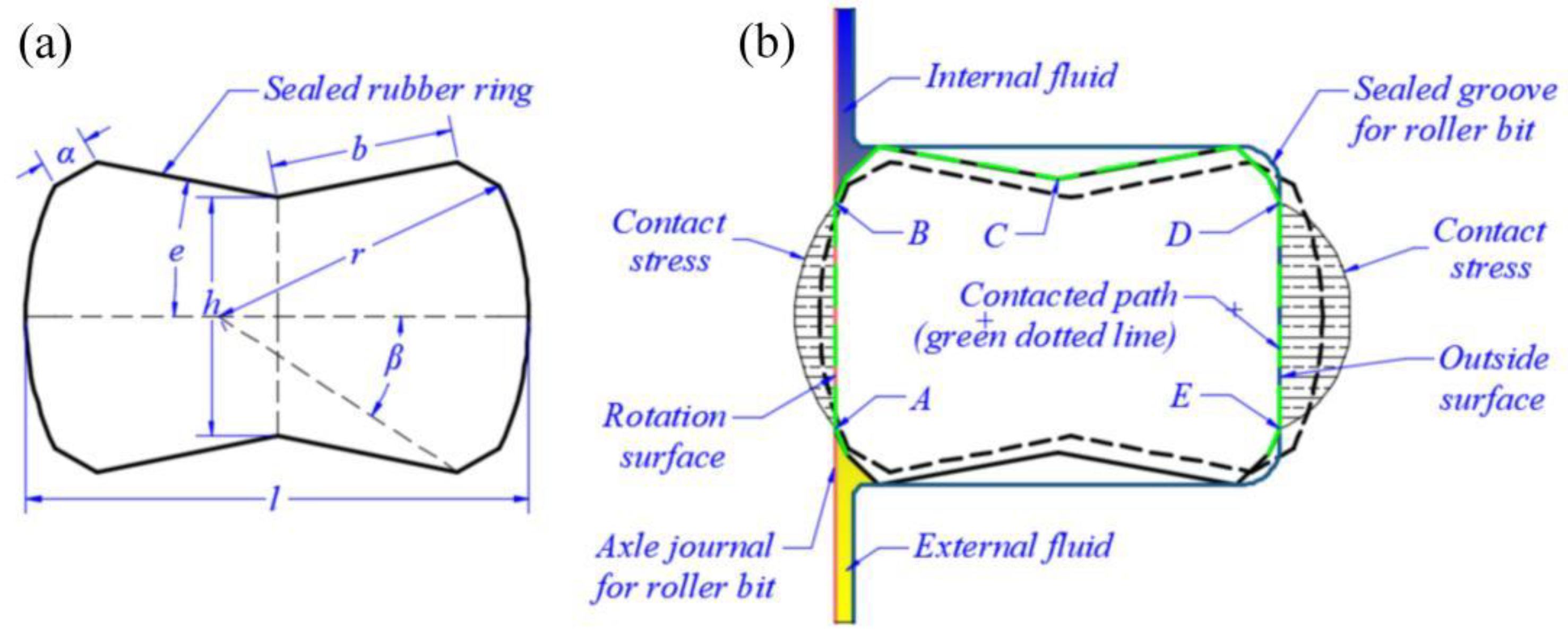

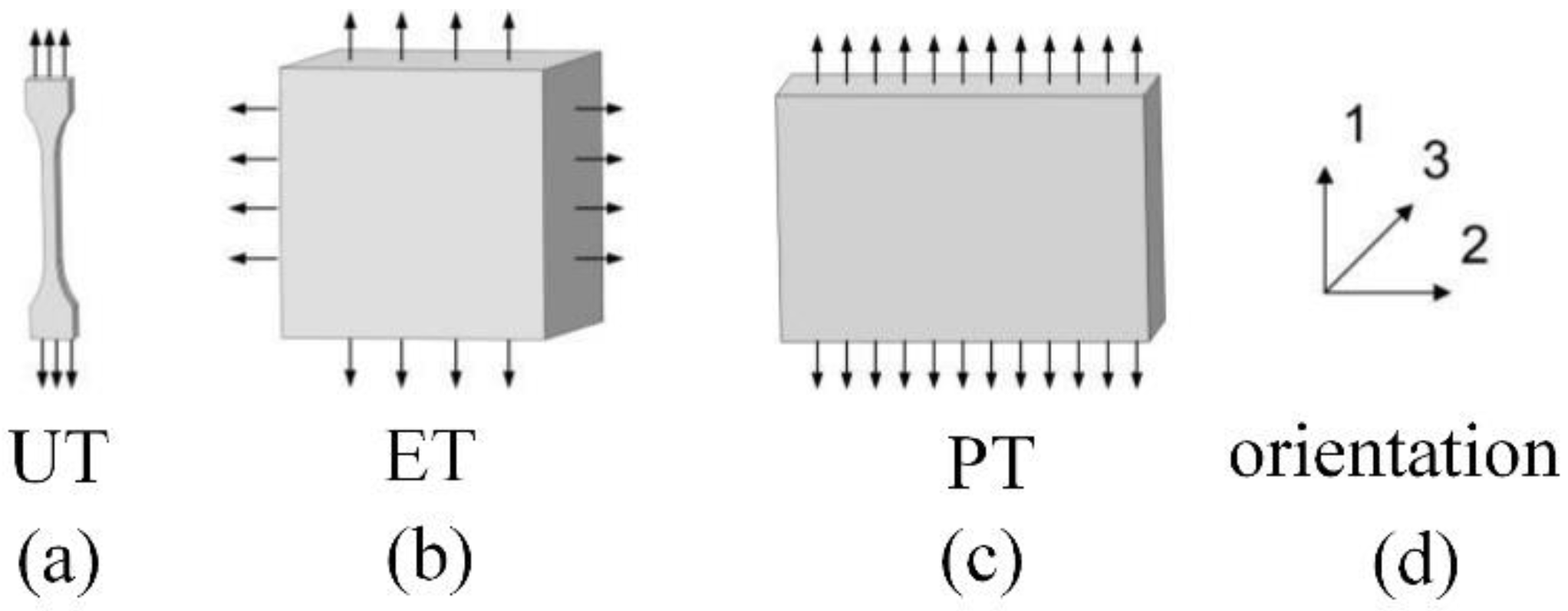
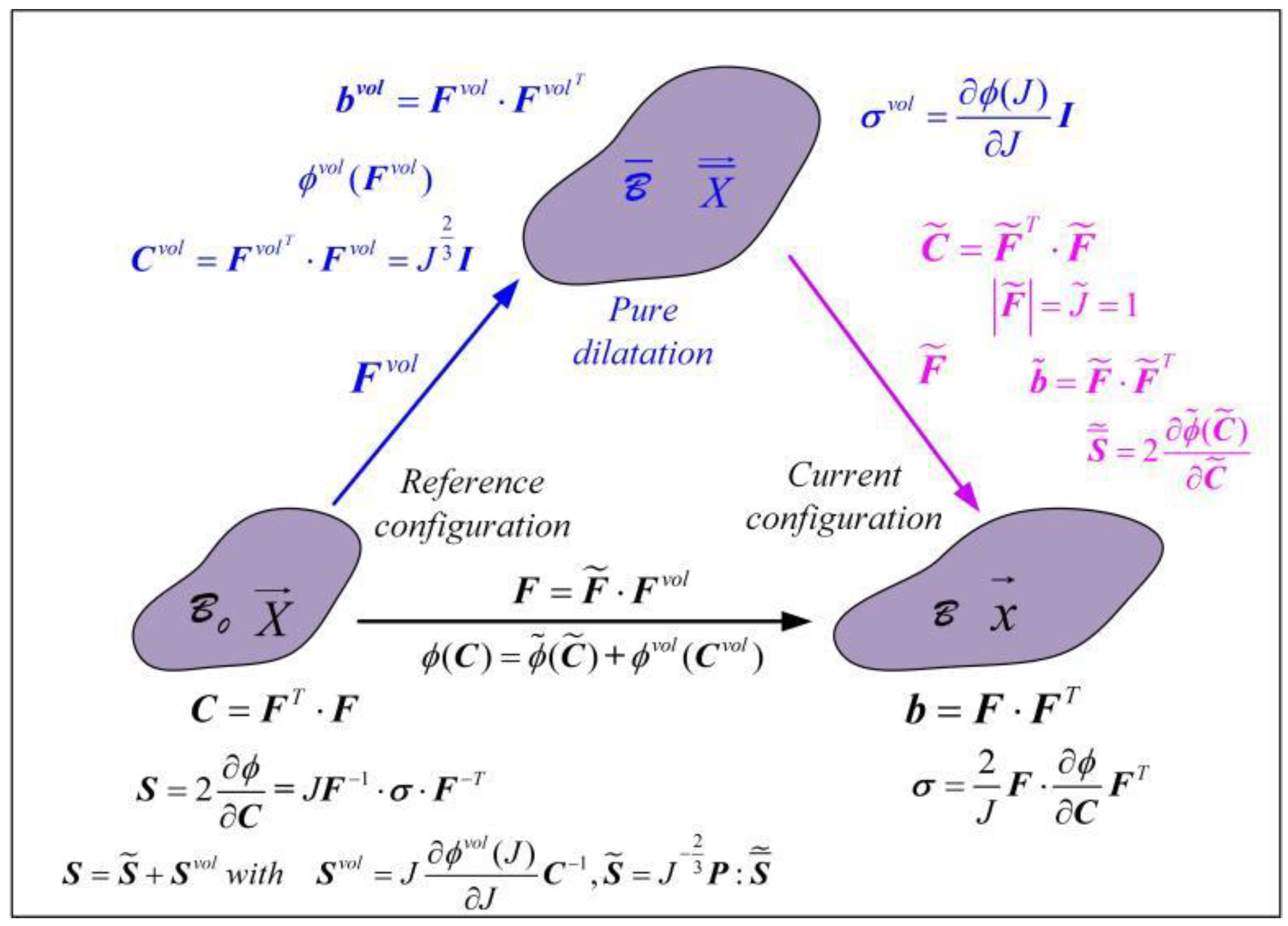
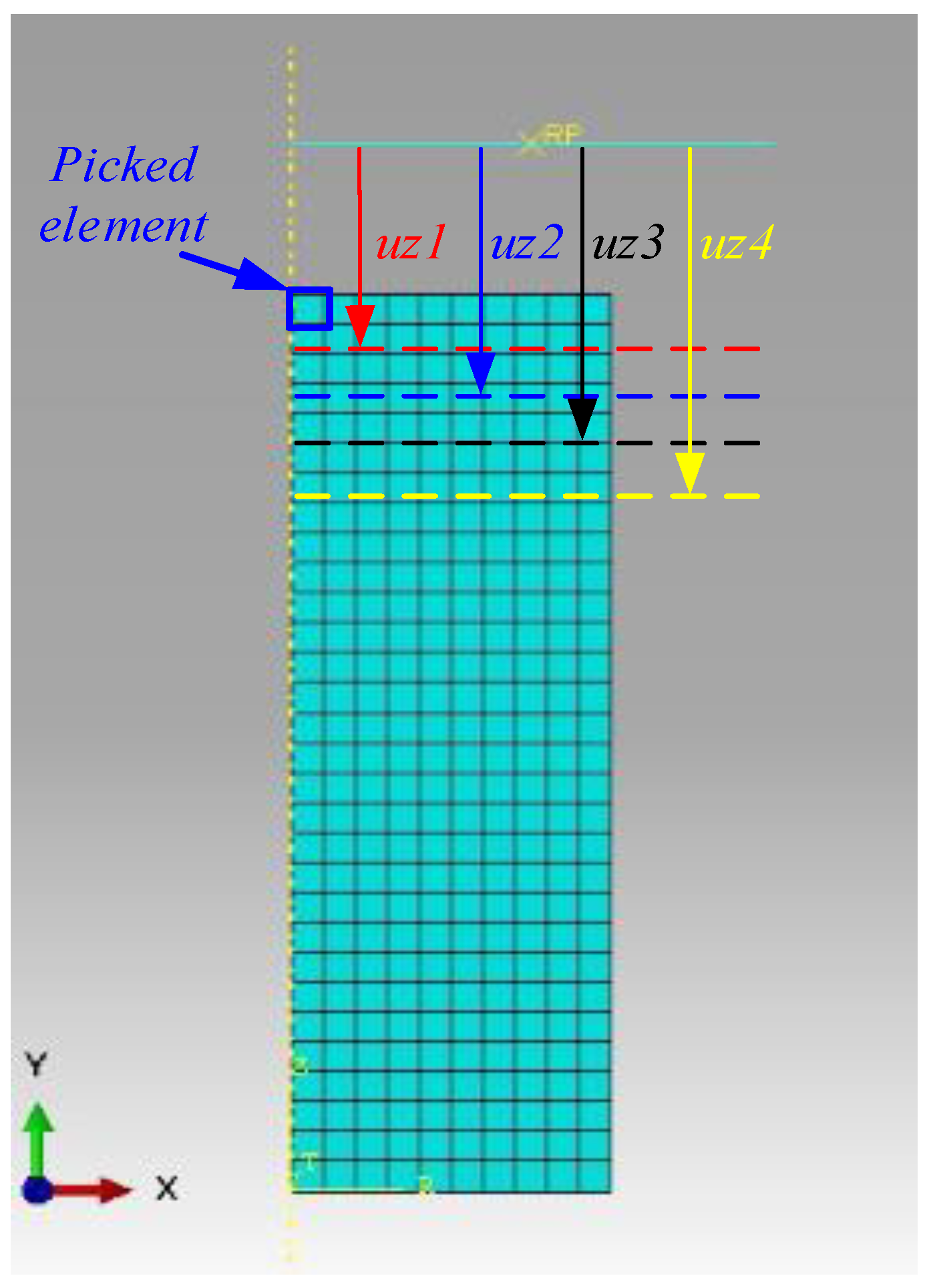
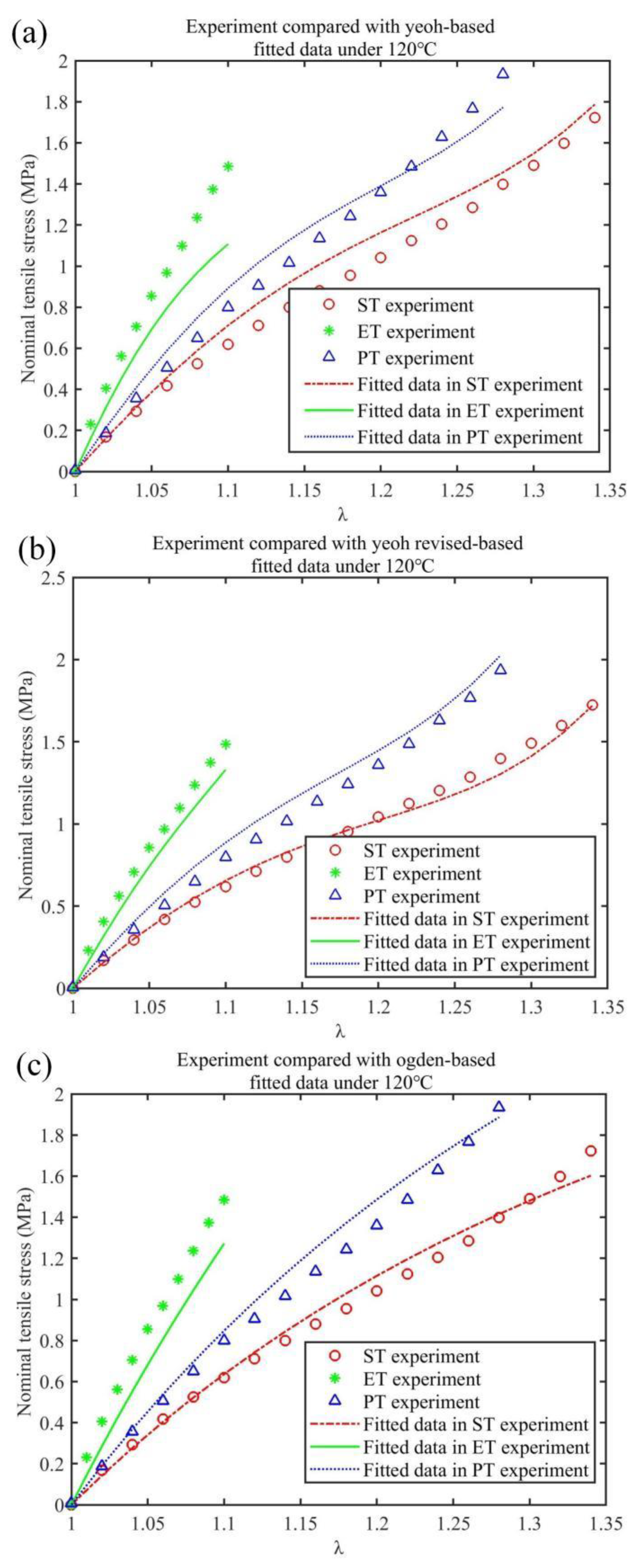
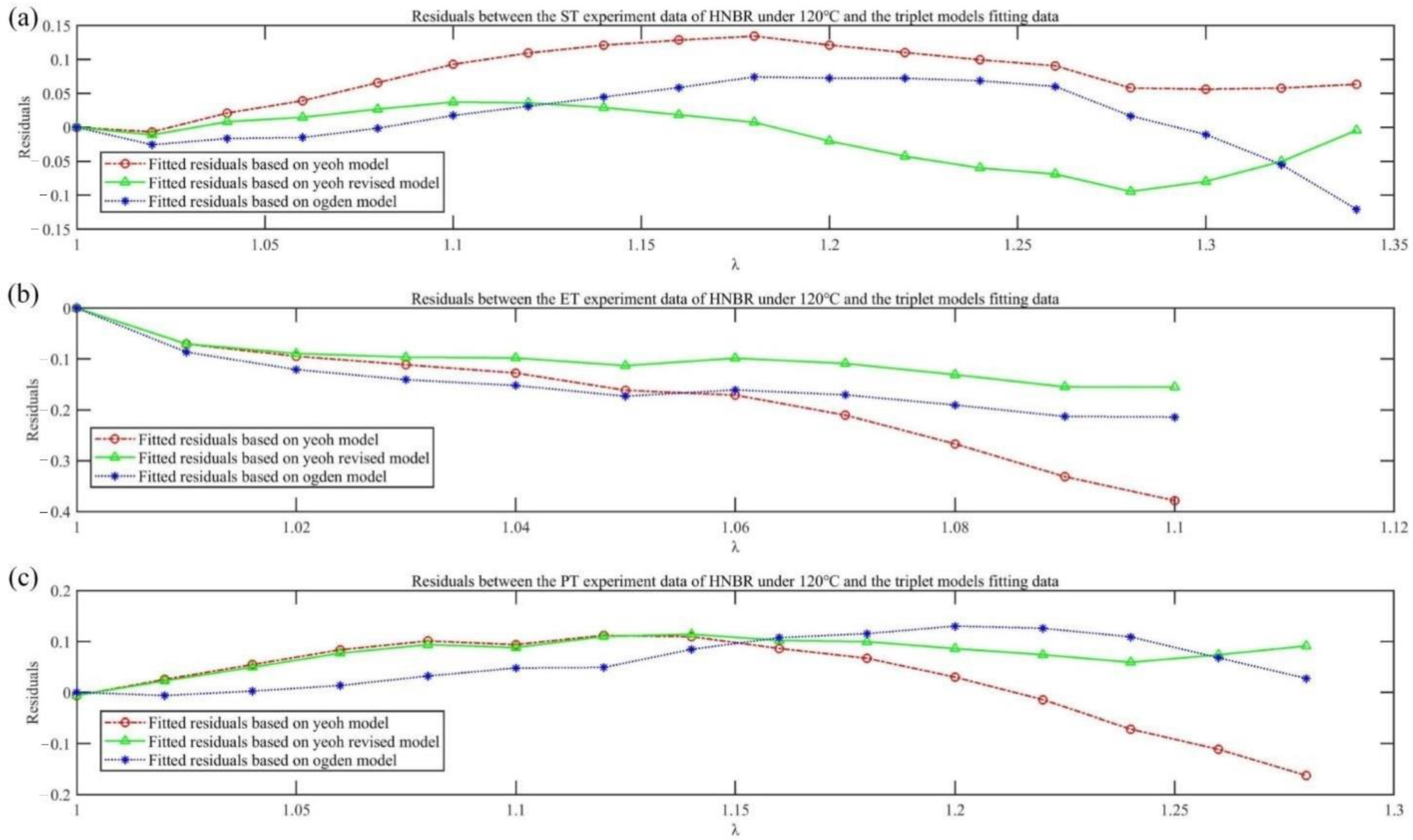
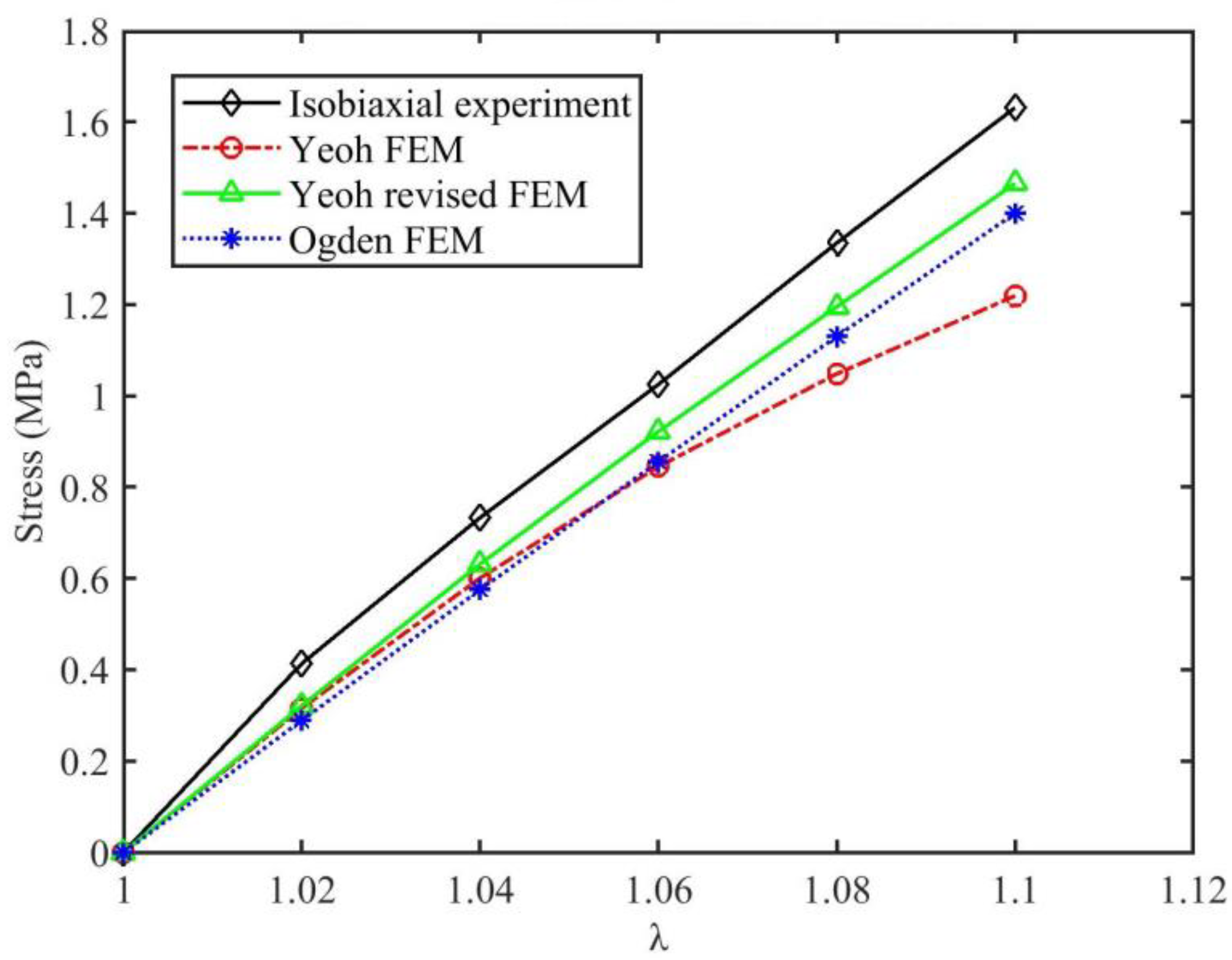
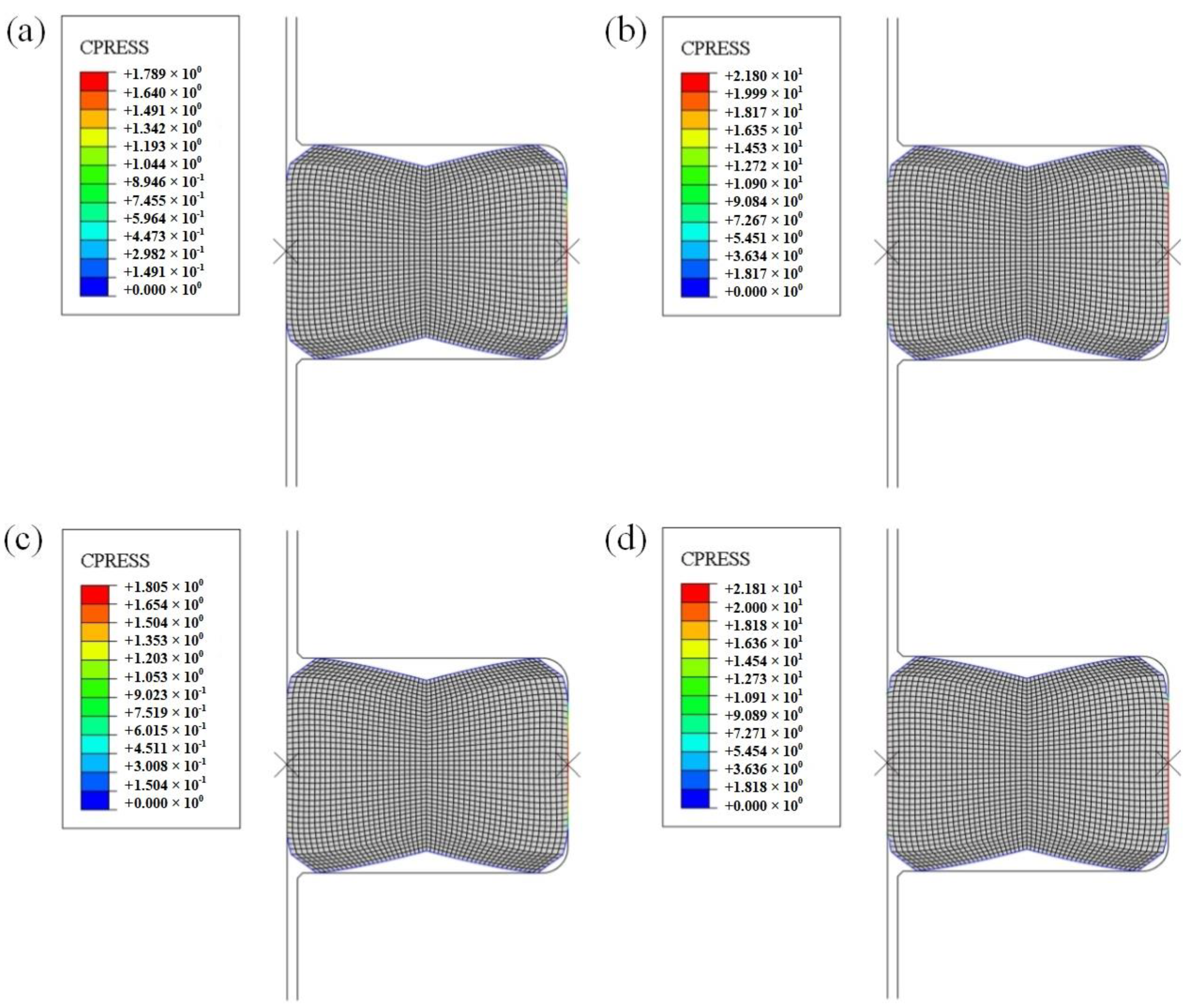
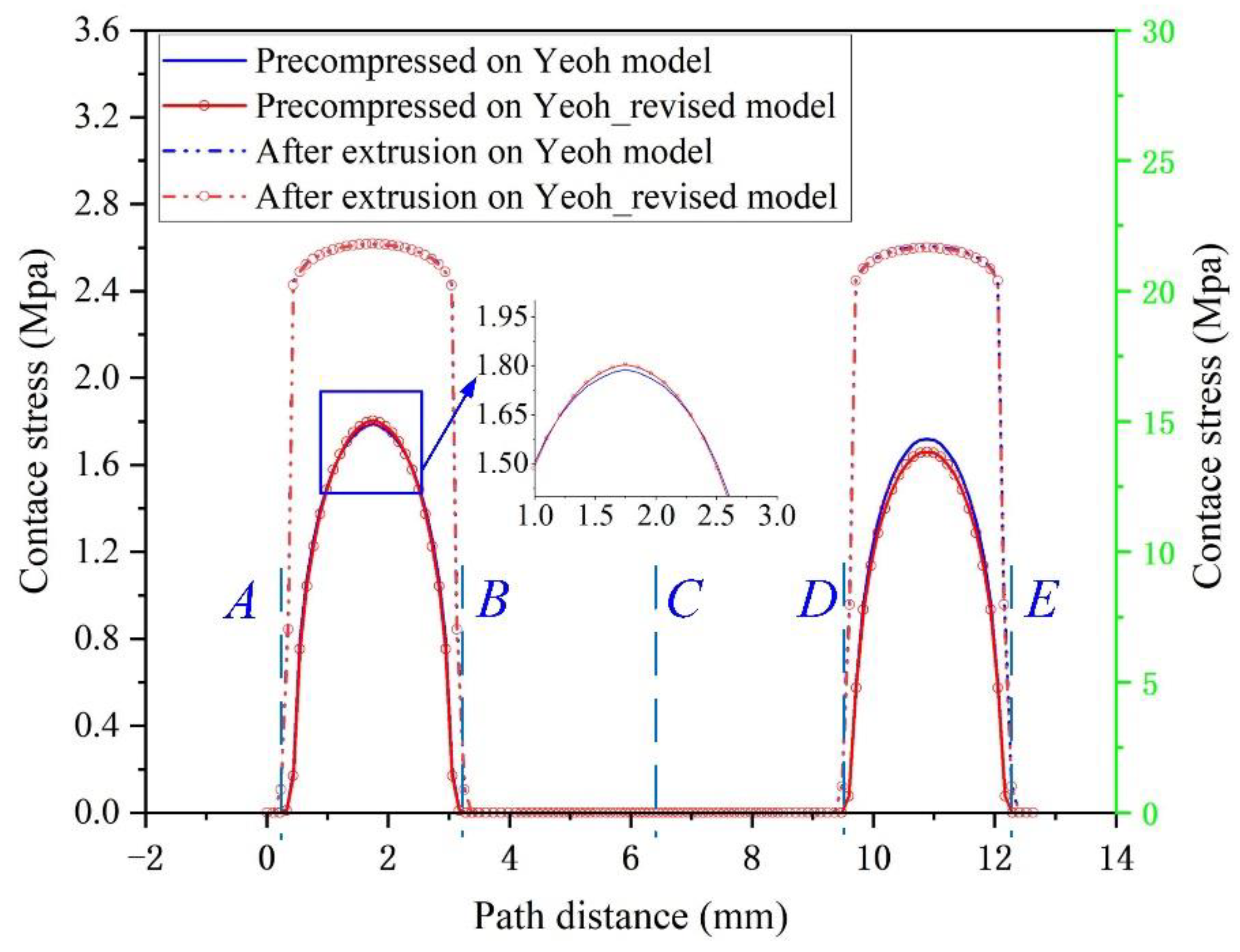
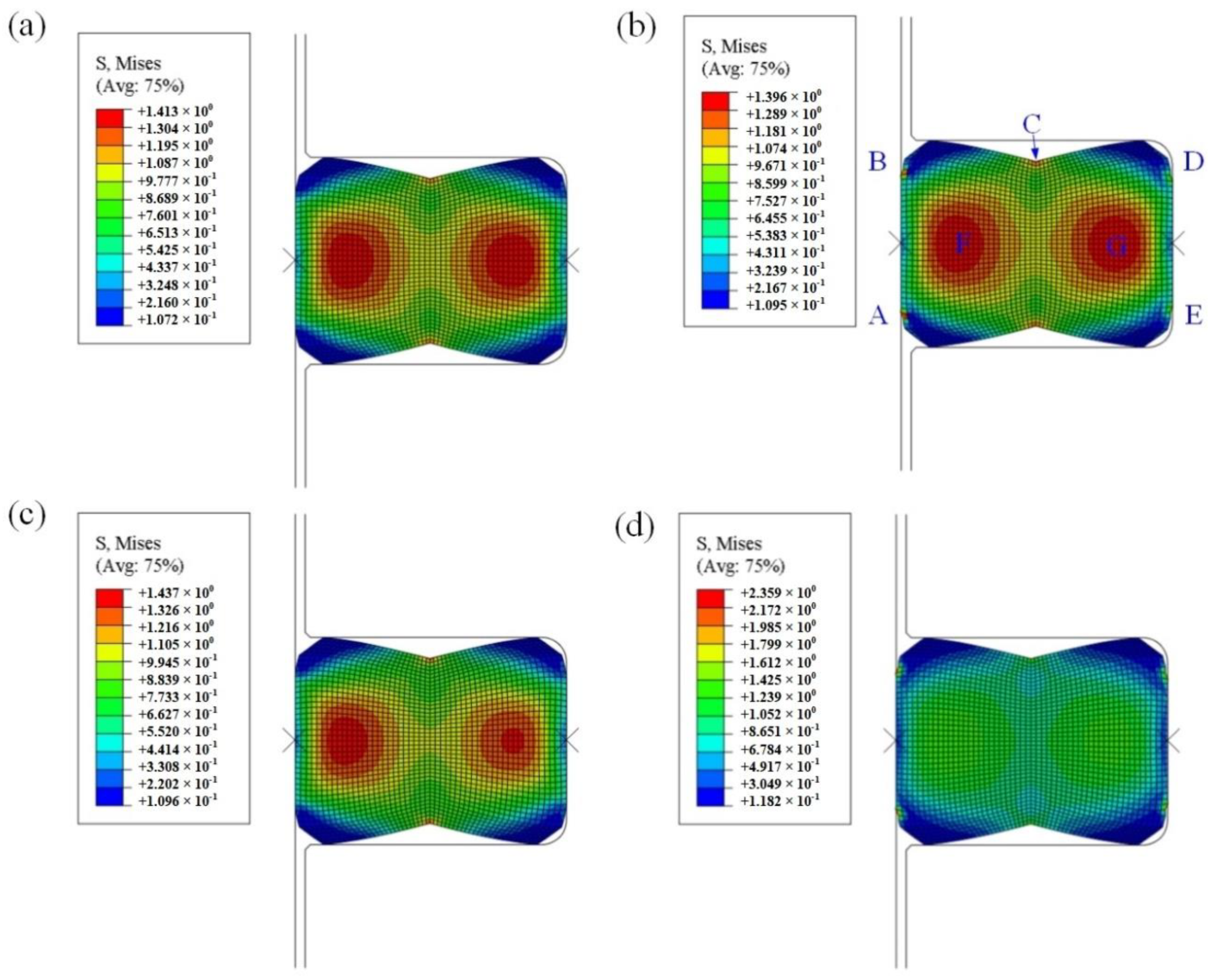

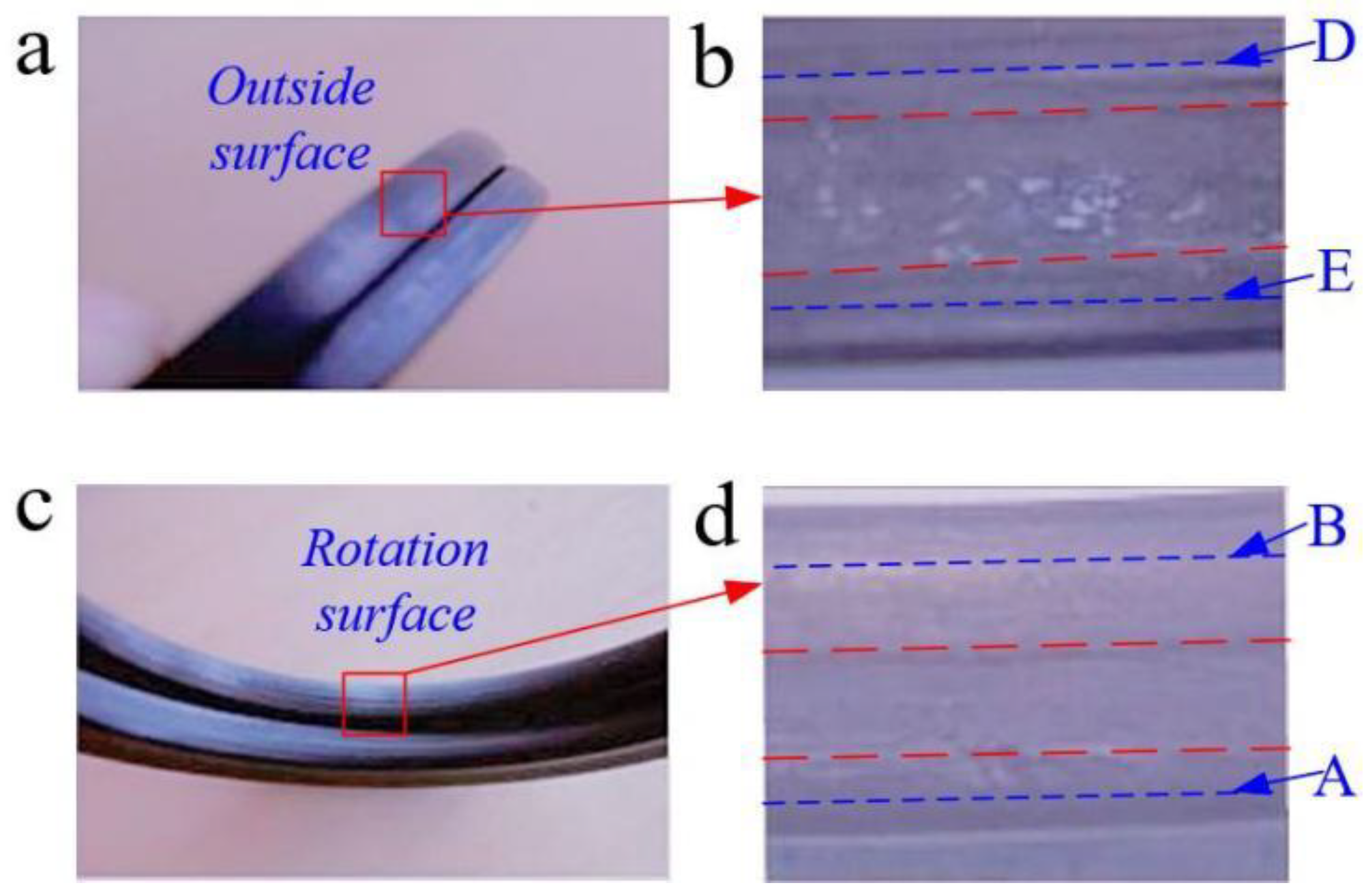
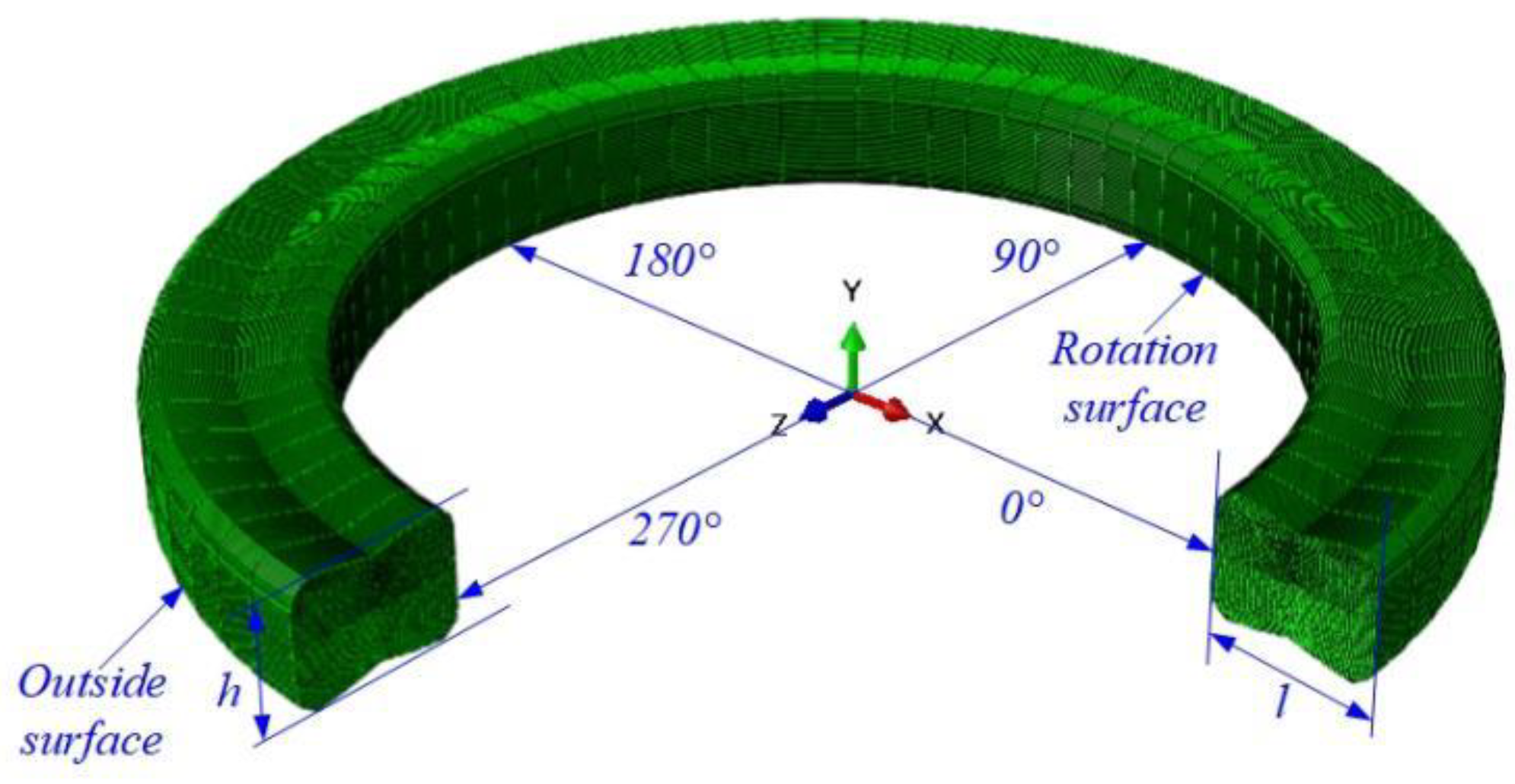
| λi | 1 | 1.02 | 1.04 | 1.06 | 1.08 | 1.10 |
| uzi | 0 | 6.16 mm | 7.26 mm | 8.30 mm | 9.28 mm | 10.21 mm |
| Yeoh | Yeoh_Revised | Ogden | |||
|---|---|---|---|---|---|
| T | 120 °C | T | 120 °C | T | 120 °C |
| C10 | 1.3745 | C10 | 0.36 | u1 | 0.8152 |
| C20 | −1.4273 | C20 | −1.3323 | α1 | −0.0003 |
| C30 | 2.3639 | C30 | 3.0578 | u2 | 0.8152 |
| / | / | C01 | 0.9965 | α2 | 0.0005 |
| / | / | / | / | u3 | 0.8152 |
| / | / | / | / | α3 | −0.0002 |
| SSdev | 0.7124 | SSdev | 0.2659 | SSdev | 0.6465 |
| R2 | 0.9385 | R2 | 0.9771 | R2 | 0.9442 |
| λ | Test_Data | Yeoh_Cae | Deviation | Yeoh_Re_Cae | Deviation | Ogden_Cae | Deviation | |
|---|---|---|---|---|---|---|---|---|
| T = 120 °C | 1.00 | 0.0000 | 0.0000 | 0 | 0.0000 | 0 | 0.0000 | 0 |
| 1.02 | 0.4137 | 0.3159 | −23.65% | 0.3213 | −22.34% | 0.2892 | −30.10% | |
| 1.04 | 0.7333 | 0.601 | −18.04% | 0.6315 | −13.88% | 0.5753 | −21.55% | |
| 1.06 | 1.0250 | 0.8451 | −17.55% | 0.9219 | −10.06% | 0.8559 | −16.50% | |
| 1.08 | 1.3346 | 1.048 | −21.48% | 1.195 | −10.46% | 1.1300 | −15.33% | |
| 1.10 | 1.6309 | 1.219 | −25.26% | 1.465 | −10.17% | 1.4000 | −14.16% |
| T = 120 °C | |||||||
|---|---|---|---|---|---|---|---|
| λ | Yeoh_Cae | Yeoh_Fit | Deviation | λ | Ogden_Cae | Ogden_Fit | Deviation |
| 1.00 | 0.0000 | 0.0000 | 0 | 1.00 | 0.0000 | 0.0000 | 0 |
| 1.02 | 0.3159 | 0.3173 | −0.43% | 1.02 | 0.2892 | 0.2905 | −0.46% |
| 1.04 | 0.6010 | 0.6008 | 0.04% | 1.04 | 0.5753 | 0.5752 | 0.01% |
| 1.06 | 0.8451 | 0.8438 | 0.15% | 1.06 | 0.8559 | 0.8546 | 0.15% |
| 1.08 | 1.0480 | 1.0466 | 0.13% | 1.08 | 1.1300 | 1.1290 | 0.09% |
| 1.10 | 1.2190 | 1.2157 | 0.27% | 1.10 | 1.4000 | 1.3959 | 0.29% |
| λ | Yeoh_re_cae | Yeoh_re_fit | Deviation | ||||
| 1.00 | 0.0000 | 0.0000 | 0 | ||||
| 1.02 | 0.3213 | 0.3227 | −0.43% | ||||
| 1.04 | 0.6315 | 0.6315 | 0.01% | ||||
| 1.06 | 0.9219 | 0.9207 | 0.13% | ||||
| 1.08 | 1.1950 | 1.1934 | 0.13% | ||||
| 1.10 | 1.4650 | 1.4608 | 0.29% | ||||
| Object | Bore Size/mm | Length of Different Phase-Angle Cross-Sections (l) | Height of Different Phase-Angle Cross-Sections (h) | Hardness/HA | |||||||
|---|---|---|---|---|---|---|---|---|---|---|---|
| 0° | 90° | 180° | 270° | 0° | 90° | 180° | 270° | Outside Surface | Rotation Surface | ||
| Before use | 54.70 | 6.25 | 6.25 | 6.25 | 6.25 | 3.90 | 3.90 | 3.90 | 3.90 | 90 | 90 |
| After use | 55.22 | 6.03 | 5.96 | 5.95 | 6.05 | 3.92 | 3.92 | 3.88 | 3.89 | 94 | 101 |
Publisher’s Note: MDPI stays neutral with regard to jurisdictional claims in published maps and institutional affiliations. |
© 2022 by the authors. Licensee MDPI, Basel, Switzerland. This article is an open access article distributed under the terms and conditions of the Creative Commons Attribution (CC BY) license (https://creativecommons.org/licenses/by/4.0/).
Share and Cite
Zhou, W.; Wang, C.; Fan, P.; Kuang, Y.; Dong, Z. The Sealing Effect Improvement Prediction of Flat Rubber Ring in Roller Bit Based on Yeoh_Revised Model. Materials 2022, 15, 5529. https://doi.org/10.3390/ma15165529
Zhou W, Wang C, Fan P, Kuang Y, Dong Z. The Sealing Effect Improvement Prediction of Flat Rubber Ring in Roller Bit Based on Yeoh_Revised Model. Materials. 2022; 15(16):5529. https://doi.org/10.3390/ma15165529
Chicago/Turabian StyleZhou, Wei, Chengwen Wang, Peng Fan, Yuchun Kuang, and Zongzheng Dong. 2022. "The Sealing Effect Improvement Prediction of Flat Rubber Ring in Roller Bit Based on Yeoh_Revised Model" Materials 15, no. 16: 5529. https://doi.org/10.3390/ma15165529
APA StyleZhou, W., Wang, C., Fan, P., Kuang, Y., & Dong, Z. (2022). The Sealing Effect Improvement Prediction of Flat Rubber Ring in Roller Bit Based on Yeoh_Revised Model. Materials, 15(16), 5529. https://doi.org/10.3390/ma15165529





